Editors’ Highlights are summaries of recent papers by AGU’s journal editors.
Source: Geophysical Research Letters
How do the deep forces of the Earth’s interior shape surface faults, fractures and rivers? The results of a new global analysis show that rivers, faults, and stresses often align, but the degree of correspondence depends on fault type, stress source, and river size.
Kuhasubpasin et al. [2025] present a new framework to quantify the relative roles of lithospheric structures and mantle dynamics, offering fresh insights into how deep Earth processes govern the surface. A novel procedure is proposed to assess the relative role of mantle flow and lithospheric differences to the surface features, which may help constrain the individual forces acting to deform the lithosphere, creating topography. This holistic perspective on the coupled evolution of Earth’s interior and its surface shows how the interior of the Earth affects and perhaps even controls the surface.
Citation: Kuhasubpasin, B., Moon, S., & Lithgow-Bertelloni, C. (2025). Unraveling the connection between subsurface stress and geomorphic features. Geophysical Research Letters, 52, e2025GL116798. https://doi.org/10.1029/2025GL116798
—Fabio A. Capitanio, Editor, Geophysical Research Letters

